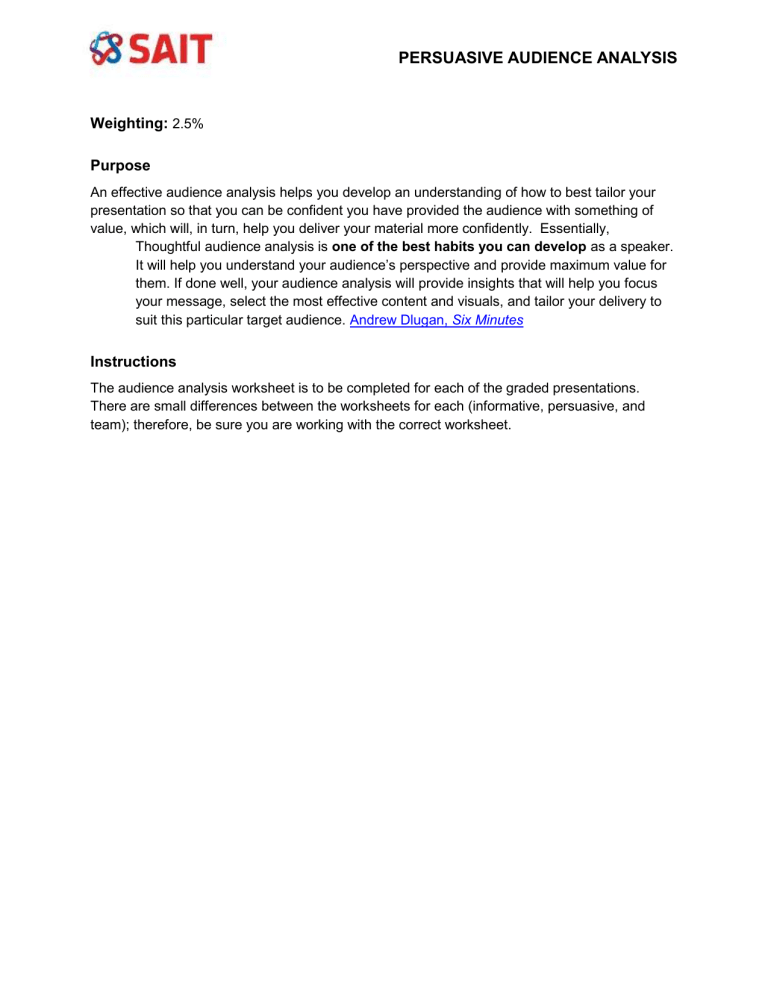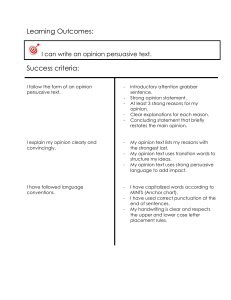
PERSUASIVE AUDIENCE ANALYSIS Weighting: 2.5% Purpose An effective audience analysis helps you develop an understanding of how to best tailor your presentation so that you can be confident you have provided the audience with something of value, which will, in turn, help you deliver your material more confidently. Essentially, Thoughtful audience analysis is one of the best habits you can develop as a speaker. It will help you understand your audience’s perspective and provide maximum value for them. If done well, your audience analysis will provide insights that will help you focus your message, select the most effective content and visuals, and tailor your delivery to suit this particular target audience. Andrew Dlugan, Six Minutes Instructions The audience analysis worksheet is to be completed for each of the graded presentations. There are small differences between the worksheets for each (informative, persuasive, and team); therefore, be sure you are working with the correct worksheet. PERSUASIVE AUDIENCE ANALYSIS Presentation Purpose: At the end of this presentation, my audience will be more closely aligned with the position that Projects are better than final exams unless they are open book- individually. Your job in your persuasive presentation is to move the audience closer to the position you are taking or the presentation. To do so, you are asked to consider the following important questions and consider how you could use your understanding of the audience to develop your presentation. Be as specific as possible in both your analysis and in your brainstorming. Criteria Why will or should the audience care about this topic and purpose? What are the audience’s most important attitudes, values and beliefs, as they relate to your topic? Analyze your audience How could you apply this information to develop your content, style, etc.? PSYCHOLOGICAL ANALYSIS The audience I find will be able to relate to this, as many people that have a test, but do not have the ability to focus on studying and potentially encounter a wall where they encounter a blockage of the information retained while studying is lost when doing the exam, it is not a good sign, nor will it fully grade / mark the student to its full potential. The class overall is very smart, passionate, and outgoing. Which would lead to the class being a good presenter and being able to engage with the audience. Witnessing them during impromptu and their presentation, everyone seemed to know their topic, understand it and explain it in their own way. Representing how they think and process a lot of things, people may not seem to be very outgoing, but grading someone on the way that they process something and how they think I PERSUASIVE AUDIENCE ANALYSIS What do they know about your topic? What don’t they know? What do they want to know/need to know in order for you to achieve your purpose? Age? Gender? Culture/Ethnicity? Socio-economic status? Do you need to consider or acknowledge any of these factors in your presentation to achieve your purpose? Do any of these help you to naturally establish ethos? Is there anything that the audience has been through in recent days, weeks, etc. that you should recognize as impacting their ability to listen to you or your stance on the topic and/or that you can acknowledge in order to get them to connect with you and/or your topic? much more valuable than a test that we will forget in the future. I am assuming that the topic and been thought of before, that exams are not a way to grade students and there should be other motives, ways, or forms to do so/ the way that an exam is done and pressure set upon is intimidating at times, teachers walking around, on your back or even switching to lock down browser with a stopwatch at sight might seem that time is going by faster. I do not think it is the need to know, but mainly that grading could be done more to test the capabilities of others, on thinking and analyzing situations, rather than a test that is a result with no rational towards it. Of course, there are subject that cannot be done presenting nevertheless those are justified. DEMOGRAPHIC & CONTEXTUAL ANALYSIS Ranges are from 18-40, multicultural (Indian, Latin, Caucasian, African, Asian), average class / Mid high class, this does not affect the topics of presentation as this is not connected with the demographic of the class. For many midterms is a heavy load of work that can weight on them a lot, and possibly family issues, money issues. This is a topic that does not directly affect my persuasive presentation nevertheless having this in mind, is always important. Potentially age is a huge factor because of the way there PERSUASIVE AUDIENCE ANALYSIS upbringing was, and adapting to a new grading system can really be hard at times. This table has been adapted from Andrew Dlugan. For a complete explanation of the significance of these questions and how you can use these to develop an audience-centered presentation, refer to his article Audience Analysis: A Guide for Speakers. PERSUASIVE AUDIENCE ANALYSIS Criteria Excellent/Good Needs Improvement Incomplete 4-5 Points 2-3 Points 0 -1 Points Audience analysis meets the following requirements: Analysis was submitted on or before the assignment deadline. Almost all rows within the table are completed. Content shows careful consideration to who the audience is (column 2) Content shows careful consideration to how an understanding of who the audience is could influence the presentation development and/or delivery (column 3) Content Audience analysis is complete, but requires more development to demonstrate a clear understanding of who the audience is and how this could or should influence the presentation development and/or delivery. Audience analysis was not submitted for grading or is almost incomplete, showing minimal analysis. TOTAL = /5




